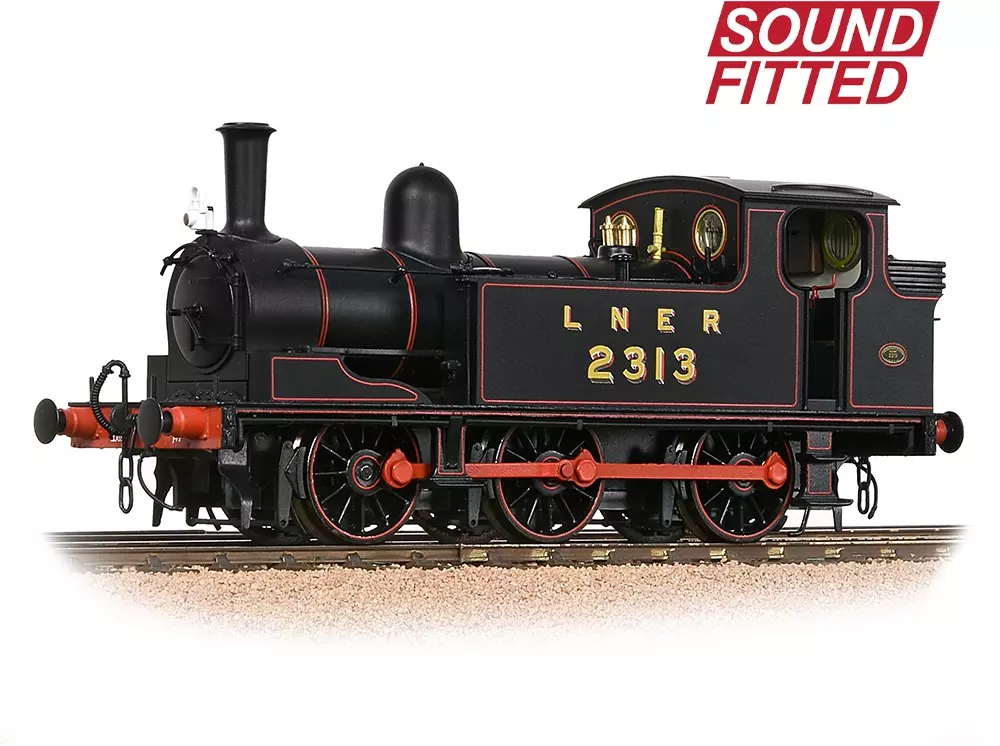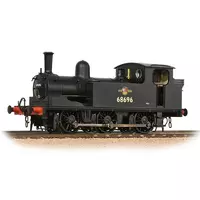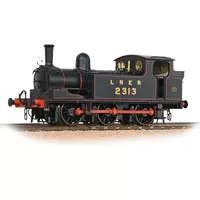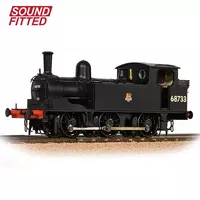Manufacturer catalogue image - please note that pre-release images may be CAD renders or CGI images rather than photographs
Prototype Era
Era 3 (1923 to 1947) The Big Four (LNER, LMS, GWR and SR)
Manufacturer description
Announced as part of our Autumn 2021 British Railway Announcements, we are delighted to offer the popular Bachmann Branchline LNER J72 Class locomotive in LNER Lined Black livery with SOUND FITTED.
This newly tooled model was designed from the ground up and features a wealth of detail including representation of the inside valve gear which can be seen beneath the boiler, sprung buffers and a cab interior which is fully detailed with intricate decoration. An accessory pack is supplied which includes headlamps that clip onto the locomotive’s lamp irons, plus three-link couplings and etched cab doors.
Enhancing the cab detail, the model features realistic firebox lighting and this has been configured with the pre-fitted DCC Sound Decoder in this SOUND FITTED model for a truly authentic operating experience- whether used on DCC or Analogue control.
MODEL FEATURES:
- Bachmann Branchline OO Scale
- Era 3
- Pristine LNER Lined Black livery
- Running No. 2313
- Accessory Pack including posable headlamps
- NEM Coupling Pockets
- Sprung Buffers
- Powerful Coreless Motor
- Realistic Firebox Lighting fitted
- Detailed and decorated cab interior
- SOUND FITTED – Fitted with a ESU Loksound Micro V5DCC Sound Decoder – See below for function list
- Length 115mm
SOUNDS
F1 - Sound On / Sound Off
F2 - Brake (activates brake sounds and increases the rate of deceleration)
F3 - Cylinder Drain Cocks
F4 – Whistle (Playable)
F5 - Normal Load / Heavy Load
F6 (STATIONARY) - Firebox Door Open (red firebox light flickers)
F6 (MOVING) - Firebox Door Open (red firebox light flickers and yellow light pulses in time with the exhaust)
F7 - Injectors
F8 - Whistle
F9 - Flange Squeal
F10 - Shovelling Coal (F6 must be On to activate this function)
F11 - Blower (with F6 On and the locomotive stopped the red and yellow firebox lights will also flicker)
F12- Hand Brake (locomotive will not move with the Hand Brake applied)
F13 - Water Tank Filling
F14 - Coupling/un-Coupling Clank
F15 - Safety Valve
F16 - Guard’s Whistle & Driver’s Response Toot
F17 - Coasting
F18 - Sound Fades Out / Sound Fades In
F19 - Shunt Mode (reduces speed)
F20 - Acceleration/Deceleration inertia off
F21 - Volume Control (LATCH = Volume On/Off) or (TRIGGER = cycles 6 Volume Levels)
F22 - Rail joint clatter
Analogue Users: Please note that exhaust and motion, automatic and randomised sounds will also operate when this model is used on analogue control (DC) straight from the box!
E1/J72 HISTORY
The J72 Class steam locomotive possess the unique record of having been constructed at varying periods over a span of 53 years by three different railway companies: the North Eastern Railway (NER), the London North Eastern Railway (LNER) and British Railways (BR).
Designed by Wilson Worsdell and originally designated Class E1 by the NER, the J72 was introduced in 1898 for light goods and shunting duties. Worsdell’s brother Thomas had introduced a similar locomotive in 1886, known as the E Class (later LNER J71), and the E1s were a development of this design, with smaller wheels but larger cylinders. Built at the NER’s Darlington Works and by Armstrong Whitworth, a total of 75 passed from NER to LNER ownership in 1924.
The LNER built ten further J72s at its own Doncaster Works in 1925 and had plans for a further 65 but these did not come to fruition. Remarkably, following Nationalisation BR built another 28 locomotives giving a total of 113 J72s with the last completed almost 53 years after the first had entered traffic.
Primarily designed for shunting and light goods duties, the NER and LNER locos were built with steam brakes, but during the 1940s vacuum brakes were fitted to some allowing them to be used on carriage shunting duties and several examples were allocated as station pilots.
Withdrawals began in 1958 and all had gone by 1964, except for two which were transferred to departmental stock for de-icing duties at Gateshead, North Blythe and Heaton. This life-extension sealed the fate of No. 69023 which was not withdrawn until 1967, by which time the preservation movement was gathering momentum and the loco was purchased by Mr R. Ainsworth who restored the loco to running order and named it ‘Joem’ after his parents, Joseph and Emmeline. Decorated in BR ‘Station Pilot’ livery, No. 69023 is now cared for by the North Eastern Locomotive Preservation Group and is a regular performer at the Wensleydale Railway.
Catalogue listing
Model details
Prototype information
* Class names often change over the lifespan of a locomotive, so this is not necessarily the class name used by the operator in the period modelled.
Supplier links are provided for your convenience and do not guarantee that the product is currently available. RailwayModels.uk is not a representative of these suppliers, but may receive a commission when purchases are made through links on this page.




